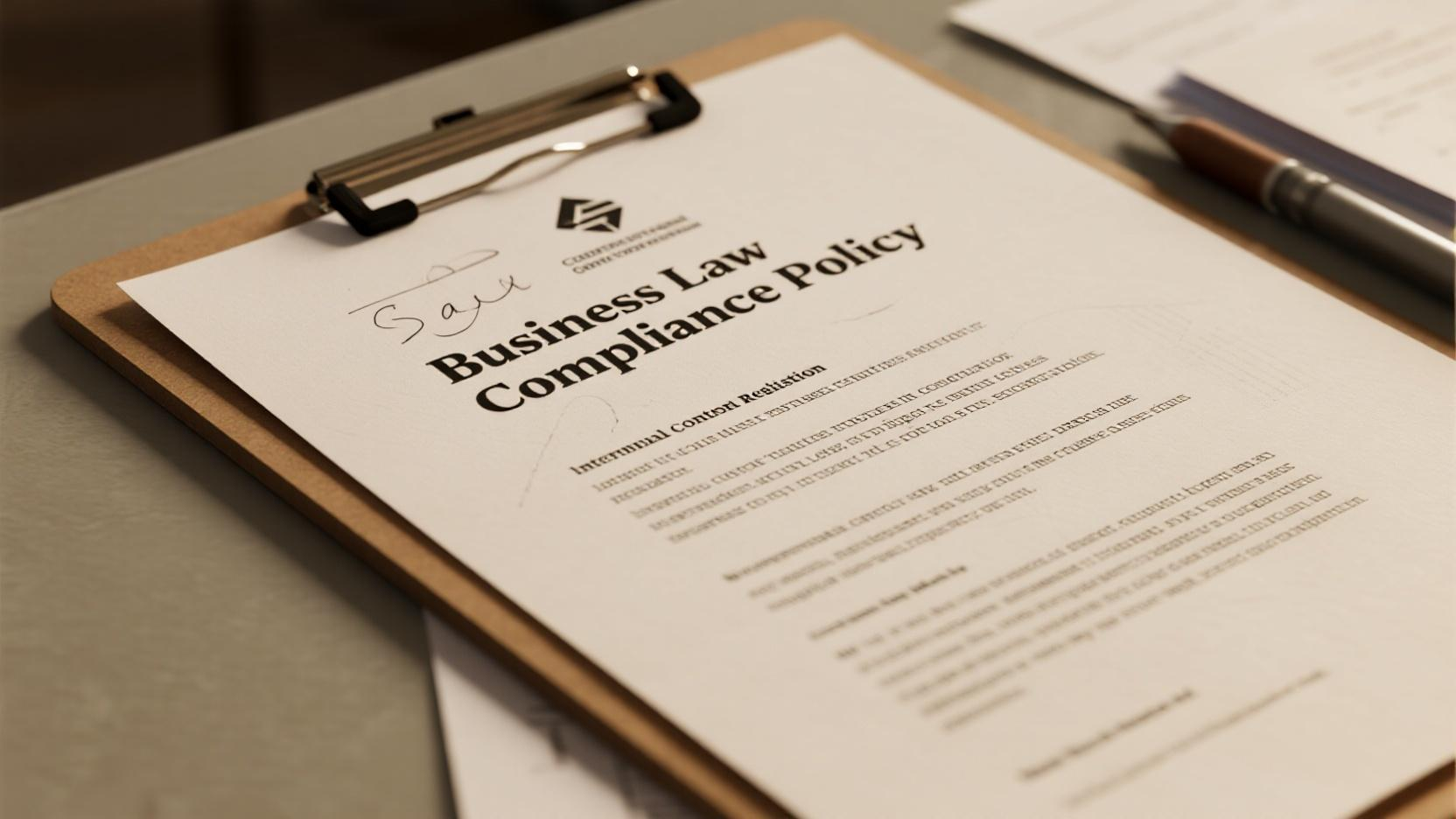Image Source: pexels
Internal compliance policies are crucial for maintaining a business’s integrity and success. They serve as Key Points for Developing and Implementing Internal Compliance Policies that help companies avoid legal issues and financial losses. For instance:
- Approximately 19% of compliance professionals reported that their companies encountered legal challenges in the past three years.
- Violating regulations can increase data breach costs by an average of $220,000.
- Organizations with poor compliance can incur breach costs reaching as high as $5.05 million.
These policies also ensure that companies adhere to ethical standards, enhance operational efficiency, and build trust with stakeholders. By prioritizing compliance, businesses can mitigate risks and achieve sustainable growth over time.
Key Takeaways
- Internal rules keep businesses safe from legal trouble and money loss. They also build honesty and trust.
- Explaining rules clearly and training often helps workers follow them well. This creates a responsible workplace.
- Technology makes managing rules easier. It saves money, boosts work speed, and helps check and enforce rules better.
Understanding Internal Compliance Policies
Definition and Purpose
Internal compliance policies are like the rules that guide a company. They help businesses follow laws and stay ethical. These rules show employees how to act responsibly at work. Examples include codes of conduct, anti-harassment rules, and data privacy guidelines.
Why are these rules important? They stop problems like legal trouble or fines. They also protect a company’s reputation. Sharing these rules clearly is key. Employees need easy access to them, like through handbooks or meetings. Training sessions teach workers how to use these rules daily. Tools like audits or compliance software help check if the company is following the rules.

Benefits for Organizations
These policies do more than prevent penalties. They build trust and responsibility in the workplace. When leaders follow the rules, employees are inspired to do the same. This creates a culture where everyone works together to stay compliant.
Data shows the benefits clearly. For example, 64% of big companies say compliance helps them organize evidence better. Also, 65% have enough money for compliance, and 62% have enough staff for it. These stats prove that investing in compliance improves efficiency and resource use.
Companies that focus on compliance reduce risks and gain trust from others. They turn complex laws into simple steps for employees. This makes it easier for workers to follow rules and help the company succeed.
Types of Compliance Policies
Regulatory Compliance
Regulatory compliance means following laws that apply to your business. This is very important to avoid legal trouble and keep trust. Rules like the Sarbanes-Oxley Act, HIPAA, and GDPR set standards for financial reports, healthcare privacy, and data protection.
Breaking these rules can cause big problems. In 2020, banks like Goldman Sachs and Wells Fargo paid billions in fines for not following them. These fines show why having rules for data safety, fraud prevention, and workplace safety is necessary.
Tip: Hire compliance officers and give regular training to meet legal rules.
Ethical Compliance
Ethical compliance is about doing what’s right, even when unseen. It’s more than just rules—it’s about building honesty. Research Compliance Standard Operating Procedures (SOPs) are a good example. They help keep research fair and protect people involved.
Ethics codes should mix rule-based and value-based ideas. This lowers legal risks and improves teamwork and culture. When leaders act ethically, employees are inspired to do the same.
Note: Strong ethics improve a company’s image and build stakeholder trust.
Industry-Specific Compliance
Different industries face different challenges, so policies must fit. For example, tech companies need data protection rules, while factories need safety standards. Companies with specific policies often perform better.
| Statistic | Description |
|---|---|
| 70% | Risk experts see compliance as a smart strategy. |
| 73% | Leaders think privacy rules lower cyber risks. |
These stats show compliance boosts efficiency and customer trust. By matching policies to industry needs, businesses can grow and compete well.
Takeaway: Custom compliance policies cut risks and create global chances.
Key Components of Effective Compliance Policies
Clear Goals and Coverage
Good compliance policies need clear goals and coverage. Everyone should know what the rules are for and who they affect. Clear policies help workers make consistent choices and understand their duties. They also help find problems and check if rules are being followed.
To make policies work, use simple words and avoid hard terms. Employees should easily find and use them often. Regularly review and update policies to keep them useful and match industry changes.
Tip: Write down everything, like risk checks and reviews, to stay open and responsible.
Legal and Ethical Match
Compliance policies must follow laws and be ethical. This lowers legal risks and builds honesty in the workplace. Policies should guide good behavior and follow rules.
| Purpose | Description |
|---|---|
| Follow laws | Makes sure the company avoids breaking rules. |
| Encourage good behavior | Sets clear rules for acting responsibly and fairly. |
| Handle risks | Spots problems early and stops them from growing. |
| Work better | Gives clear steps to avoid confusion and save time. |
When policies follow laws and values, they help workers make smart choices and earn trust from others.
Watching and Enforcing Rules
Watching and enforcing rules is key for success. Without this, even great policies won’t work. Tools like data checks can find risky actions, like bribery. Alerts for bad activities help fix problems fast.
Compliance teams need quick access to important data. Regular checks and tests show how well the rules work. For example, tracking complaints and how they’re solved shows the program’s success.
Note: Strong enforcement finds rule-breaking and stops it from happening again by showing responsibility.
Steps to Develop Internal Compliance Policies
Conduct a Risk Assessment
Start by checking for risks that could harm the company. This step helps find problems early. Follow these steps:
- Plan the Assessment: Decide what to check and gather resources.
- Build the Team: Pick skilled people with different talents.
- Get Leadership Support: Make sure leaders agree and share the goals.
This process helps you understand risks and fix them. For example, while making a data privacy rule, I found issues with storing private data. Fixing this early stopped legal problems later.
Define Policy Objectives
Clear goals make compliance policies work better. Write down what the policy should do and who it affects. For example, when creating a code of conduct, explain its purpose, like encouraging good behavior, and who it applies to, like all workers.
Studies show clear goals help companies follow rules and look better. Use simple words and pictures to make policies easy to understand. This way, employees can follow them without confusion.
Engage Stakeholders
Involve important people like managers and team leaders. Their ideas make policies more useful. For example, when making safety rules, workers shared risks I didn’t notice.
Getting their input also makes them more likely to follow the rules. When people feel included, they support the policies more.
Draft and Review Policies
Write the policies using templates to save time. Adjust them to fit the company’s needs. After writing, review them with experts and team members. Check policies often to match new laws and trends.
For instance, I updated a cybersecurity rule to stop phishing scams. This kept the company safer and improved compliance. Regular updates also help create a culture of always improving, which is key for strong compliance policies.
Steps to Implement Compliance Policies
Share Policies Clearly
It’s important to explain policies so everyone understands them. Using different ways to share information works best. For example:
| Way to Share Information | What It Does | Example Use |
|---|---|---|
| In-person Meetings | Direct and personal, great for detailed talks and quick feedback. | Explaining a new company rule that affects all departments. |
| Emails | Gives detailed info that can be saved and checked later. | Sharing a new data privacy rule with step-by-step instructions. |
| Company Website or Intranet | Stores all policy documents in one place for easy access. | Keeping updated rules in an organized online folder. |
You can also use surveys to check if workers understand the rules. Their feedback helps improve how you explain policies.
Tip: Use simple words and pictures to make rules easier to follow.
Offer Training and Tools
Training helps workers learn and remember the rules. Regular, fun sessions work best. For example:
- Host workshops to explain new rules.
- Use short quizzes to check what workers remember right away.
- Do follow-up surveys to see what they recall later.
Compliance teams should create lessons that fit the company’s needs. About 19% of compliance workers said they faced legal problems. This shows why good training is so important.
Note: Make sure there’s enough money and time for training programs.
Add Policies to Daily Work
Rules should fit into everyday tasks to work well. Companies do better when they include compliance in their routines. For example:
- Add rule checks to project planning tools.
- Use software to spot possible rule-breaking automatically.
Leaders need to show they follow the rules too. When they do, workers are more likely to copy them. This creates a workplace where following rules feels normal.
Set Up Checks and Reports
Checking systems help track if rules are being followed. Regular reviews and inspections show where changes are needed. Try these ideas:
- Set clear goals to measure how well rules are followed.
- Create ways for workers to report problems they see.
Good reporting systems let managers see issues early. Fixing problems quickly stops them from getting worse.
Takeaway: Watching and reporting builds trust and keeps everyone responsible.
Overcoming Challenges in Compliance Policy Implementation
Building a Compliance Culture
Creating a compliance culture is key for lasting success. A strong ethical base builds trust, lowers risks, and boosts morale. Companies with good ethics perform 40% better in customer and employee satisfaction. This proves compliance is more than rules—it’s about valuing honesty at work.
But many companies find it hard to measure culture. For example, Charlie struggled to understand how her workers viewed ethics. Tools that check ethical actions can help solve this issue. Surprisingly, 80% of ethics experts lack data to study workplace culture. This shows why building a compliance culture is vital for policy success.
Tip: Talk often about compliance and praise ethical workers. This helps create a positive culture.
Handling Resistance to Change
Change can be hard when adding new compliance rules. Workers may resist because they fear changes to their routines. To fix this, involve them early in the process. When I worked on a project, asking for feedback eased concerns and made adapting easier.
Good change strategies are also important. Research shows clear communication and leader support reduce resistance. Leaders should set an example by following compliance rules. This inspires workers to accept and follow changes too.
Note: Be open and honest. Workers accept changes better when they know the reasons behind them.
Using Technology for Compliance
Technology makes managing compliance easier. Tools like cloud systems save time and cut mistakes. For example, companies using tech see 41% lower costs and 63% higher productivity. These tools help track compliance, spot risks, and follow rules.
| Source | Evidence |
|---|---|
| Harvard Business Review | 30% fewer compliance issues in the first year of using cloud tools. |
| Deloitte | Companies with tech are 70% more likely to succeed in compliance. |
| McKinsey & Company | 40% fewer incidents and 25% lower costs in the first year. |
A McKinsey study showed a global company had great results with compliance tech. They saw 40% fewer problems and saved 25% in costs within a year. These facts show tech is both helpful and cost-saving.
Takeaway: Use technology to make compliance easier and more effective.
Internal compliance policies are important for a company’s success. Key steps include checking for risks, setting clear goals, and using policies daily. Making compliance a priority helps reduce problems, build trust, and grow steadily over time.
FAQ
What should you do first to create compliance policies?
Begin with a risk check. This finds problems and makes sure the policies focus on the most important areas.
How can employees be encouraged to follow compliance rules?
Explain the rules clearly and train workers often. Use things like workshops, short tests, and surveys to help them understand and stick to the rules.
Why does technology matter for managing compliance?
Technology makes tracking rules easier and reduces mistakes. Tools like cloud systems save time, cut costs, and spot problems early.
Tip: Pick tools that match your company’s needs for the best results.












